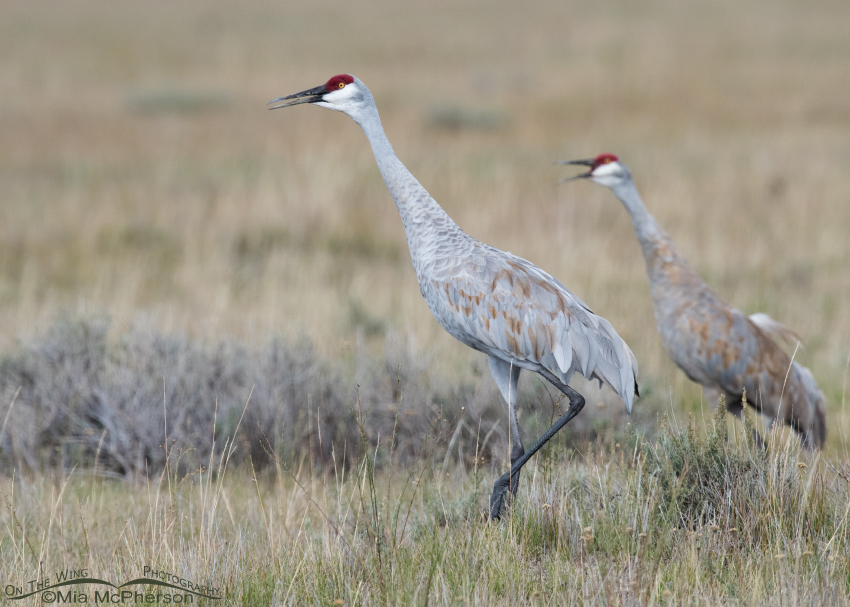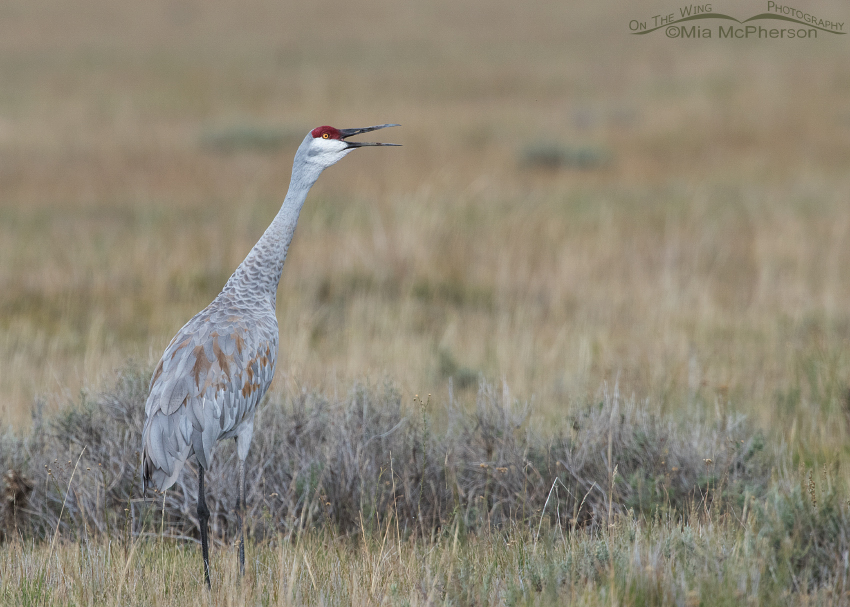I was delighted to find quite a few Sandhill Cranes in the Centennial Valley of Montana last week and this pair was close enough to photograph.
 Mated pair of Sandhill Cranes – Nikon D810, f7.1, 1/1250, ISO 640, Nikkor 500mm VR with 1.4x TC, natural light, not baited
Mated pair of Sandhill Cranes – Nikon D810, f7.1, 1/1250, ISO 640, Nikkor 500mm VR with 1.4x TC, natural light, not baited
The male is nearly finished molting and has become mostly gray compared to the reddish color they have during breeding season when they stain their feathers with soil.
 Calling male Sandhill Crane – Nikon D810, f7.1, 1/1250, ISO 640, Nikkor 500mm VR with 1.4x TC, natural light, not baited
Calling male Sandhill Crane – Nikon D810, f7.1, 1/1250, ISO 640, Nikkor 500mm VR with 1.4x TC, natural light, not baited
During my time in the Centennial Valley I saw several flocks ranging from 10 to 26 individuals.
It is nearing the time when the Sandhill Cranes will migrate south for the winter and perhaps this pair will pass through Utah on their way to their wintering grounds.
 Female Sandhill Crane – Nikon D810, f7.1, 1/1250, ISO 640, Nikkor 500mm VR with 1.4x TC, natural light, not baited
Female Sandhill Crane – Nikon D810, f7.1, 1/1250, ISO 640, Nikkor 500mm VR with 1.4x TC, natural light, not baited
The female appeared more stained than the male but she is no where near as red as she would have been even a month ago. I was disappointed that this pair did not have young with them, they may have lost their chicks due to a cold snap during the incubation period or lost the chicks to predation.
Young sandhills generally stay with their parent for around 328 days and if this pair’s young had survived they would have been nearby.
 Sandhill Crane pair calling – Nikon D810, f7.1, 1/1250, ISO 640, Nikkor 500mm VR with 1.4x TC, natural light, not baited
Sandhill Crane pair calling – Nikon D810, f7.1, 1/1250, ISO 640, Nikkor 500mm VR with 1.4x TC, natural light, not baited
This image shows the difference in the cranes stained plumage well I think though I am not sure why the female shows more of the reddish stain than the male.
 Male Sandhill Crane behavior – Nikon D810, f7.1, 1/2000, ISO 640, Nikkor 500mm VR, natural light, not baited
Male Sandhill Crane behavior – Nikon D810, f7.1, 1/2000, ISO 640, Nikkor 500mm VR, natural light, not baited
The male did some dancing, jumping and calling while I photographed him. I am not sure though if that was because of our presence or if it was to maintain the pair bond.
 Dancing male Sandhill Crane – Nikon D810, f7.1, 1/2500, ISO 640, Nikkor 500mm VR, natural light, not baited
Dancing male Sandhill Crane – Nikon D810, f7.1, 1/2500, ISO 640, Nikkor 500mm VR, natural light, not baited
I have never been to the Centennial Valley of Montana where I didn’t see or hear Sandhill Cranes and for me it would be very strange to be in the valley when the cranes aren’t there.
Any day now though they will leave the valley until early next spring when their calls will once again trumpet in the valley.
Life is good.
Mia
Click here to see more of my Sandhill Crane photos plus facts and information about this species.





Excellent set of images!!
Hi! I do not think I ever saw a live sandhill crane before? You did a great getting so many poises of them!
Have a great day of shooting in the morning!
Fascinating. Love the pieces of his ballet you captured too. Thank you.
What amazing light in that last one and I’m so jealous you saw so many. We have quite a few pairs here in the valley but they are very difficult to get close to.
Mia, great detailed photos. Perhaps those cranes will be among the 1000’s that winter here in Alabama, though I think they would go more directly south. We have a couple thousand cranes that winter on Wheeler Wildlife Refuge in northern Alabama and they share the area with about 20 whooping cranes that have also chosen to spend their winter here. Both are a treat to watch and photograph.
What wonderful images! Some birds take dust baths supposedly to rid themselves of mites. Is this how these birds stain their feathers? I checked the link and was surised to see how darkly stained they can get. Interesting! A flock of them rose up from the road to Rapid and cicled over head when I was visting friends on the Pine Ridge rez. In South Dakota. It was thrilling to see and hear them…
Beautiful! Can’t wait until they arrive in the Central Valley of CA. They winter about an hour south of me and I make many trips down to photograph them during the winter months. One of my favorite birds.